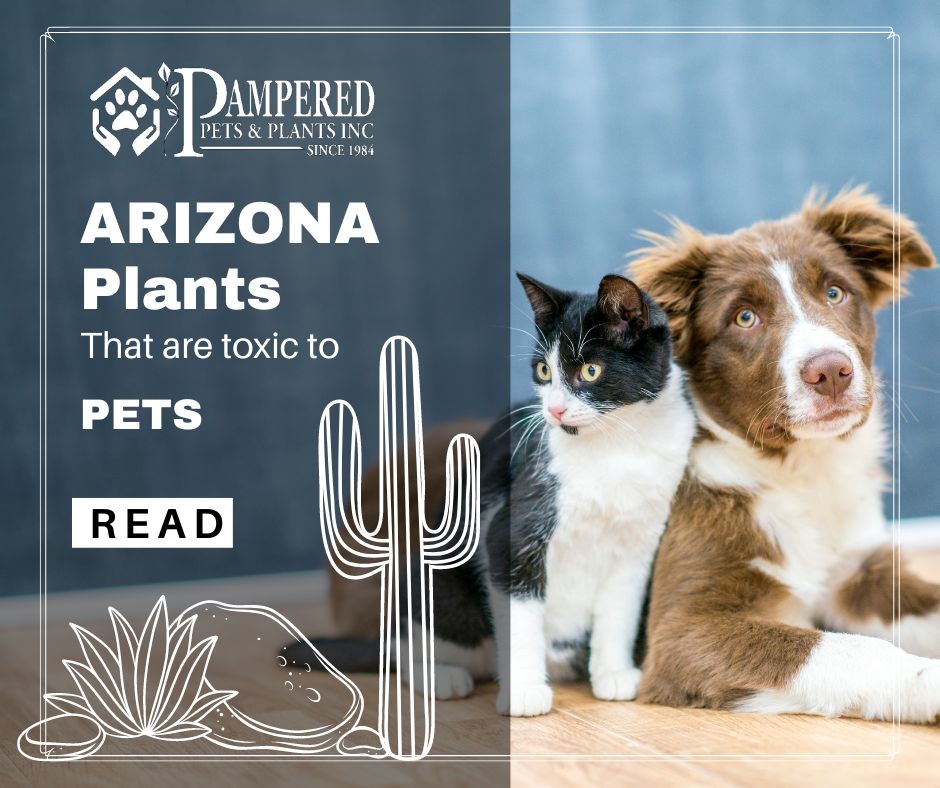If you’re new to Arizona, you may not know this, but we’ll let you in on a secret: Everything in this state is designed to poke, poison or pierce flesh. We love our desert, but trust us when we say it is one of the most dangerous environments in the world for pets (you can see why in our Top 10 List of Dangers for Pets). But, our plant life is in a class by itself…
The Sonoran desert is the most biodiverse desert in the world. Arizona is home to over 2,000 native species of plants and all of them are fighting for survival in a harsh environment. This means that you need to train your pets to avoid all things that live in the area. Including plants, lest they become a statistic.
About Arizona Plants
Desert plant life, while hostile, is hostile for a reason. The Saguaro cactus can live up to 200 years and Southern Arizona is the only place in the United States where you can see them. Everything in the desert has to fight for survival. While we have done our best to list the most toxic plants, remember that all plants can be toxic to pets if they consume enough. These are just a few of the more well-known items that can cause problems…
Always teach your pets to avoid plants, and especially keep an eye on younger pets who love to consume anything they can get their paws on!
Arizona Plants that are Toxic to Pets
Our plants are as varied as our state’s landscape, from the pine trees in the tundra region, to moss in the aquatic range. This is why it’s so important to know your yard and surrounding foliage. If you can’t identify each of your plants, it’s time to get busy with a plant identifier app or by doing some serious research. The ASPCA has one of the best lists of toxic and non toxic plants in Arizona (and other areas).
NOTE: This is not a complete list. Be sure to fully research plant types, varieties and more when you’re evaluating your yard.
Popular Trees that are Toxic to Pets
- Apple Tree
- Apricot Tree
- Australian Flame Tree
- Avocado
- Bead Tree
- Black Laurel
- Black Locust
- Boxwood
- Cacao
- Cherry Tree
- Chapparal (Bottlebrush, Creosote, Greasewood)
- Chinaberry Tree
- Elderberry
- Eucalyptus
- Flame Tree
- Glottidium (sesbania)
- Golden Chain (Laburnum)
- Oak
- Poinciana
- Red Maple – While not entirely toxic to pets, dried or wilted red maple leaves can pose a toxicity risk to dogs. These leaves contain tannins and gallic acid, substances that can harm red blood cells, leading to hemolysis. Symptoms may include anemia, weakness, dark urine, breathing difficulties, abortion, and potentially fatal outcomes.
- Crimson Bottlebrush
- Creosote
Popular Flowers that are Toxic to Pets
- Azaleas
- Rhododendron
- Crocus
- Azalea
- Baneberry
- Bird Of Paradise
- Bleeding Heart
- Bloodroot
- Bluebonnet
- Bulb Flowers (including Irises, Lilies, Calla Lily, Daffodil, Autumn Crocus, Arum Lily, Tulips)
- Camel Bush
- Caldium
- Cardinal Flower
- Castor bean
- Chrysanthemum
- Clematis
- Cocklebur
- Coffee
- Coral
- Cyclamen
- Four O’Clock (Marvel of Peru)
- Foxglove
- Geranium
- Gladiolas
- Heaths
- Holly
- Honeysuckle
- Horse Chestnut
- Horsetail
- Hosta
- Hydrangea
- Jasmine (yellow)
- Jimson weed
- Lantana
- Larkspur
- Lily Of The Valley
- Lupine
- Mandrake
- Mexican Bird of Paradise
- Mexican Poppy
- Mistletoe
- Monkshood
- Moonseed
- Morning Glory
- Mountain Laurel
- Nightshades
- Oleander (especially yellow)
- Peach Tree
- Periwinkle
- Philodendron
- Plum Tree
- Poinsettia
- Primrose
- Rain Tree
- Ranunculus (Buttercup)
- Snowdrop
- Star of Bethlehem
- Sweet Pea
Popular Fruits, Vegetables, and Herbs that are Toxic to Pets:
- Chives
- Coriander
- Garlic
- Grapes
- Hops
- Leeks
- Marijuana
- Onions
- Rhubarb
- Tansy
- Tobacco
- Tomatoes
- Potato Shoots
- Yarrow
Bushes, Flowers, Vines, Weeds:
- Bishop’s Weed
- Bracken Fern
- Buckthorn
- Burdock
- Chalice
- Dieffenbachia
- Elephant Ear (Taro)
- Euonymus (Spindle)
- English Ivy
- False Hellebore
- Felt Plant
- Firethorns
- Ground Cherry
- Heliotrope
- Hemlock
- Henbane
- Holly (winterberry)
- Ivy
- Jimsonweed
- Laceflower
- Lantana
- Milkweed
- Mistletoe
- Mock Orange
- Moonseed
- Vetch
- Oleander
- Pigweed
- Poison Ivy
- Poison Oak
- Pokeweed
- Privet
- Pyricantha
- Rapeseed
- Spurges
- Wisteria
- Yews
Fungi & Algae:
- Blue-Green Algae
- Mushrooms
Cactus
While cacti isn’t “toxic” per se, it does a pose a real and dangerous threat to your pets. Please avoid these in your yard. If they are already in your yard, be sure to train your pets to avoid.
- Century Plant
- Sago Palm (very deadly if consumed)
- Cholla (all varieties)
- Saguaro
SAFE Desert Plants to Grow Around Pets
So, what can you grow in our desert environment? Quite a few!
- American rubber plant (common names: pepper face, baby rubber plant)
- Blue echeveria (common names: maroon chenille, painted lady, copper rose, wax rosette, plush plant, “hen and chicks”)
- Boston fern (common names: Boston fern, sword fern)
- Cast iron plant (common name: bar-room plant)
- Christmas cactus (which can show off flowers, hence the flashy common names Easter cactus and holiday cactus)
- Donkey’s tail, a succulent (common names: horse’s tail, burro’s tail, lamb’s tail)
- Parlor palm (common names: miniature fish tail dwarf palm, good luck palm, bamboo palm)
- Spider plant (common names: ribbon plant, Anthericum, spider ivy)
- Swedish ivy
Pet Friendly Plants & Flowers:
- African Violets (Cape Marigold)
- Begonias
- Boston Fern
- Bromeliads
- Christmas Cactus
- Coleus
- Creeping zinnia
- Daisies: Gerbera daisy (common names: Transvaal daisy, African daisy, Veldt daisy)
- Hoya
- Jade Plant
- Lipstick plant
- Marigolds
- Petunia
- Phalaenopsis orchid (common names: moth orchid, moon orchid, butterfly orchid, phals)
- Roses
- Rubber Plant
- Spider Plant
- Zinnia
Pet Friendly Bushes
- Black hawthorn (common names: blackthorn, thorn apple, May bush)
- Chaparral (common names: creosote bush, greasewood)
- Crimson bottlebush
- Magnolia bush
- Mulberry bush greenbrier
- Rose (but watch the thorns!)
Pet Friendly Trees:
- Big shellbark hickory
- Bitter pecan (common name: water hickory)
- Bottle palm
- Carob tree
- Fig tree
- Figleaf palm
- Iron tree (common names: Maui sunset, flame of the woods)
- Japanese aralia
- Mockernut hickory
- Mulberry tree
- Pupleosier willow
- Red maple (see notes above as this is not “entirely” safe)
- Silver bell tree
- Tree cactus
- Tulip poplar (tulip tree)
Don’t forget to learn about the other things that can injure you and your pets in the wild west of Arizona!


